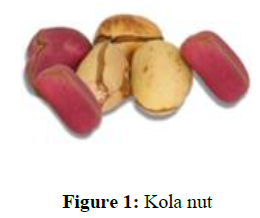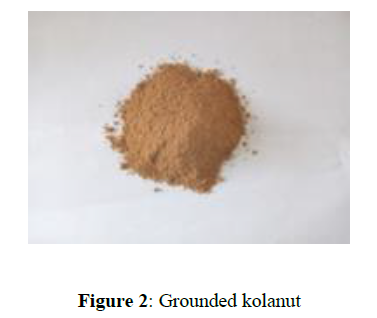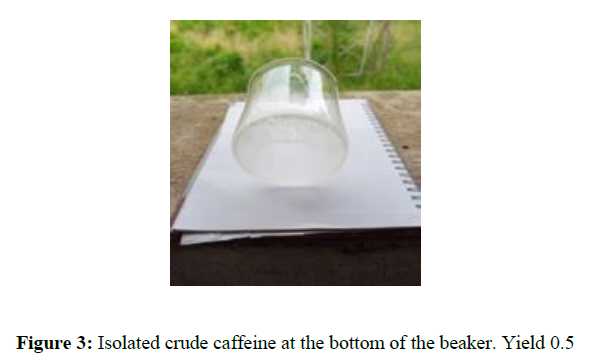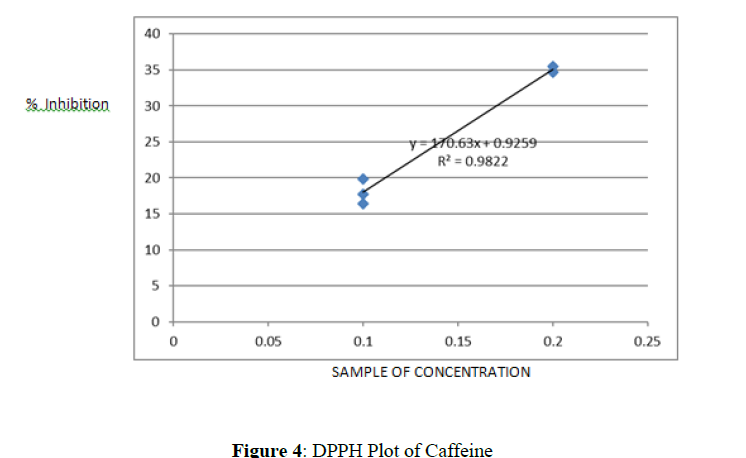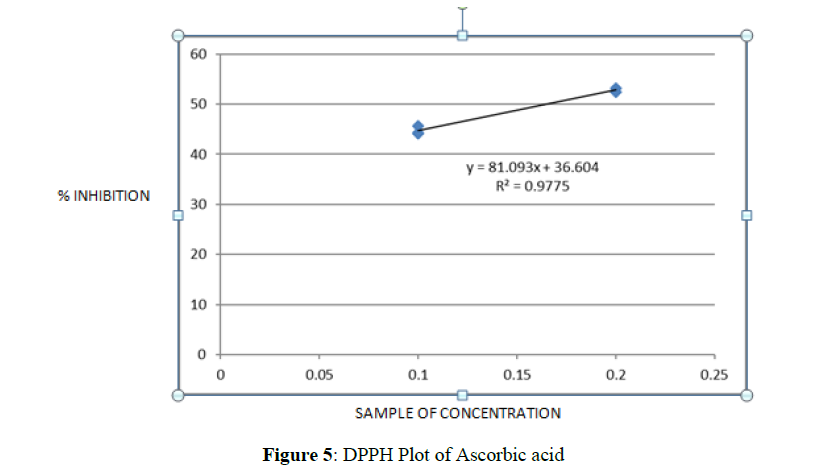Research Article - Der Pharma Chemica ( 2021) Volume 13, Issue 8
Evaluation of Antioxidatant Activity of Caffeine Isolated from Kolanut (cola nitida)
Onyeyilim Ebuka Leonard1*, Ugwu Ezinne Evelyn1, Otunomo Idowu Iyabo1, Uzoewulu Chiamaka Peace1 and Onugwu Adaeze Linda22Department of Pharmaceutics, University of Nigeria, Nsukka, Nigeria
Onyeyilim Ebuka Leonard, Department of Pure and Industrial Chemistry, University of Nigeria, Nsukka, Nigeria, Email: ebuka.onyeyilim@unn.edu.ng
Received: 29-Jul-2021 Accepted Date: Aug 20, 2021 ; Published: 28-Aug-2021
Abstract
Crude caffeine was isolated from kola nut, by treating the filtrate obtained from powdered kola nut with lead (II) acetate to precipitate acids and albumins, along with HCl to precipitate lead ions, and to make some insoluble tannins to be soluble, then Na2CO3 solution was added to neutralise the acidic HCl solution. Dichloromethane is added to the filtrate to extract the caffeine from the aqueous layer and then distilled to obtain the crude caffeine. The extracted crude caffeine is recrystallized with activated charcoal and tested for its antioxidant capacity, using the DPPH assay, which screens the antioxidant activity of plant extracts. The DPPH (2, 2-diphenyl-1-picrylhydrazyl) in methanol helps to facilitate the extraction of the antioxidant compounds from the sample. Ascorbic acid (Vitamin C) is used as the standard for this assay, due to its appreciable antioxidant activity. The IC50 value was calculated from the graph of % inhibition against concentration, and the extracted caffeine from kola nut was found out to have a high antioxidant activity comparable to that of the standard, ascorbic acid.
Keywords
Kolanut, Caffeine, DPPH, Vitamin C, Antioxidant Activity
Introduction
Kola is a common name for a genus of about 125 species of evergreen trees and their trees are best known for their seeds or nuts which are rich in caffeine and used in the manufacturing of carbonated soft drinks known as kola beverages. They can relieve migraine, and can be used in states of depression, or weakness and even in the treatment of malaria fever [1]. They can also be used to prepare tonic, as a remedy for dysentery, coughs, diarrhoea, vomiting and chest complaints. Kola is one of the major sources of caffeine and taking kola nut by the mouth, in large doses is likely unsafe, due to its caffeine content and frequent chewing can lead to stained teeth [2, 3]. Adisa also carried out a significant research and reported on the effects of aqueous extract of kola nut on the reproductive hormones in rat [4]. The result of this study shows that kolanut extract significantly reduced plasma level of luteinizing hormone but significantly increased plasma testosterone level. The reduced plasma luteinizing hormone level reported in this study is in agreement with findings of Benie and Thieulant [5], where it was reported that kolanut extract exerted an inhibitory effect on luteinizing hormone release of rat’s pituitary cells, however our findings on plasma level of testosterone was in agreement with Leehayward [6], that caffeine increases plasma level of testosterone. But contrary to the findings of Rebecca and Elizabeth [7], who reported that bioavailable testosterone was negatively and independently associated with caffeine intake, while estrone was positively associated with high levels of caffeine consumption in post-menopausal women. The active chemical constituents of all the species of kola nut include: caffeine, glucoside, theobromine and kolatin which are stimulants [8]. (Figure 1)
The symptoms of caffeine intoxication are not unlike overdoses of other stimulants. It may include restlessness, fidgetiness, nervousness, excitement, and euphoria, insomnia, flushing of the face, increased urination, gastrointestinal disturbance, muscle twitching, a rambling flow of thought and speech, irritability, irregular or rapid heartbeat, and psychomotor agitation [9]. In cases of much larger overdoses, mania, depression, lapses in judgment, disorientation, disinhibition, delusions, hallucinations, and psychosis may occur, and rhabdomyolysis (breakdown of skeletal muscle tissue) can be provoked [10,11]. In large amounts, and most especially, over an extended period of time, caffeine can lead to a condition known as caffeinism [12]. Caffeinism usually combines caffeine dependency with a wide range of unpleasant physical and mental conditions including irritability, anxiety, tremulousness, and muscle twitching (hyperreflexia), insomnia, headaches, respiratory alkalosis, and heart palpitations [13,14]. Parvathy reported the chemical analysis of caffeine content in tea and coffee samples [15]. Okolie reported the effect of heat on caffeine isolated from kolanut [16]. Caffeine has even been suggested as possible cause of cancer, though no studies have confirmed yet [17]. Caffeine relaxes the internal anal sphincter muscles and thus should be avoided by those with fecal in continence [18]. Caffeine citrate may confer a modest protective effect against some diseases, including Parkinson’s disease [19].
Antioxidants are compounds that inhibit oxidation or substances that at low concentrations prevents the oxidation of a substrate. A chemical reaction that can produce free radicals and chain reactions that may damage the cells of organisms, have antioxidants such as thiols or ascorbic acid (vitamin C) that may act to inhibit these reactions. The antioxidant capacity is a measure of the amount of a certain free radical captured by an antioxidant sample [20]. To balance oxidative stress, plants and animals maintain complex systems of overlapping antioxidants, such as glutathione. The only dietary antioxidants are vitamins A, C, and E.
The aim of this research is to investigate the antioxidant activity of caffeine isolated from kolanut grown in Nsukka, eastern part of Nigeria. The choice of this research arises from the fact that kola nut contains most essential phytochemicals which are suspected to have antioxidant behaviour and is believed to possess numerous biological properties. Also it has been found that most of the physiological actions of kola are due to caffeine [21] and caffeine content of kola nut varies with difference in climatic and adaphic factors [22].
Materials and Method
Sample Preparation
The kola nuts used in this study were obtained from Nsukka, Enugu State, Nigeria. The kola seeds were washed, reduced in size and sun dried for four days. The reduced kola seeds were further grounded using an electric grinder and sun dried again for two days, after which it was manually grinded with a clean and dried mortar and pestle to obtain a powdered form of the kolanut.(Figure 2)
Isolation of Caffeine from Kolanut
Caffeine was isolated and purified following Johnson’s method as reported by Okolie. 20 g of kola nut was weighed into a metal pot. 150 cm3 of water was added to it and boiled for about 12 minutes. 40 cm3 of 0.3M lead (II) acetate was added while the mixture was made hot to precipitate acids and albumin. The hot mixture of kola and water plus additives was filtered using a white cloth. The solids were filtered and re-boiled with 100 cm3 of water while a stand by hot water was used to wash the system. After filtration, 20 ml of 2 M hydrochloric acid was added to the filtrate to precipitate lead ions. The lead chloride was filtered off. 30 ml of 1M sodium carbonate solution was added to the solution gradually until it was slightly alkaline and concentrated to four times its initial strength. The concentrate was settled for about two minutes, decanted, and the sediment was filtered with filter paper while hot. The filtration was kept hot with steam. The latter filtrate, which has been cooled, was combined with the decanted portion before drip extraction. The conc. filtrate was extracted 4 times, with 15 cm3 portions of dichloromethane. The mixture was frequently inverted in each extraction and allowed to stand for at least 9 minutes before isolation of layers. The extracts were combined, and the chloroform was distilled to ¼ of its original volume. The remaining chloroform was evaporated to dryness to obtain the crude caffeine. The crude caffeine was purified by dissolving in hot water, activated charcoal was added to absorb the gas and the colouring matter, and then it was filtered. The filtrate was cooled to room temperature, followed by drip extraction. The solvent was evaporated on a hot plate. The purified dry caffeine was recovered and stored in a desiccator. (Figure 3)
Antioxidant Activity test
Procedure: 0.1g of the extracted caffeine and 0.1g of ascorbic acid (standard control) was weighed into different beakers, treated with 20 ml of methanol respectively and stirred for five minutes. They were filtered, and the filtrates were covered with aluminum foils and left for a while. 0.1, 0.2, 0.4, 0.6, 0.8 and 1.0 ml(s) of the respective solutions (caffeine and ascorbic acid) were measured into 6 different test tubes, and diluted serially, such that the volume of solutions in the respective test tubes were 1.0 ml each. Also, 0.0039 g/L of DPPH was prepared, with methanol, and kept in a closed space; due to its high sensitivity to light (i. e. it has the ability to undergo photochemical decomposition). 5 ml of the DPPH solution was added to the 1.0 ml solutions in the various test tubes (which were the caffeine solution and the standard solution), and they were all confined in a closed space for about an hour. The absorbance of these solutions were determined on a UV/V Spectrophotometer, which was set at 517 nm, while using 10ml of methanol as the blank solution. (Table 1) (Figure 4,5)
| Caffeine | Ascorbic acid | |||
|---|---|---|---|---|
| Dose mg /mL | Absorbance | % Inhibition | Absorbance | % Inhibition |
| 0.1 | 0.311 | 17.725 | 0.207 | 44.355 |
| 0.1 | 0.303 | 19.841 | 0.208 | 44.086 |
| 0.1 | 0.316 | 16.402 | 0.202 | 45.699 |
| 0.2 | 0.247 | 34.656 | 0.174 | 53.226 |
| 0.2 | 0.244 | 35.449 | 0.177 | 52.419 |
| 0.2 | 0.246 | 34.921 | 0.179 | 51.882 |
| 0.4 | 0.237 | 37.302 | 0.141 | 62.097 |
| 0.4 | 0.23 | 39.153 | 0.144 | 61.29 |
| 0.4 | 0.235 | 37.831 | 0.147 | 60.484 |
| 0.6 | 0.233 | 38.359 | 0.108 | 70.968 |
| 0.6 | 0.234 | 38.095 | 0.104 | 72.043 |
| 0.6 | 0.236 | 37.566 | 0.105 | 71.774 |
| 0.8 | 0.176 | 53.439 | 0.082 | 77.957 |
| 0.8 | 0.17 | 55.027 | 0.085 | 77.151 |
| 0.8 | 0.173 | 54.232 | 0.088 | 76.344 |
| 1 | 0.133 | 64.815 | 0.052 | 86.022 |
| 1 | 0.131 | 65.344 | 0.056 | 84.946 |
| 1 | 0.136 | 64.021 | 0.059 | 84.139 |
Results and Discussion
DPPH assay is the ideal choice used in this test because it is rapid, simple, inexpensive, and can be monitored over time. IC50 value of an antioxidant is the concentration of the antioxidant required to give 50% or half inhibition of the probe in the antioxidant assay. From literature, it is noted that low IC50 values denotes high antioxidant activity, and comparing the IC50 values of the isolated caffeine and the standard (ascorbic acid), we notice that although, ascorbic acid has a lower value, which is expected, since it is the known antioxidant and was used as the standard control. The I C50 value of the isolated caffeine showed a little difference, (which is almost negligible) when compared to the standard as seen in table 2.
| Caffeine | Ascorbic acid | |||
|---|---|---|---|---|
| Concerntration | % Inhibition | IC 50 (ppm) | % Inhibition | IC 50 |
| (mg/ mL) | (Mean & S. D) | (Mean & S. D) | (ppm) | |
| 0.1 | 17.989 ± 2.453 | 0.2876 | 44.713 ± 0.706 | 0.1652 |
| 0.2 | 35.009 ± 0.330 | 0.2876 | 52.509 ± 0.552 | 0.1652 |
| 0.4 | 38.095 ± 1.348 | 0.2876 | 61.290 ± 0.658 | 0.1652 |
| 0.6 | 38.007 ± 0.330 | 0.2876 | 71.595 ± 0.457 | 0.1652 |
| 0.8 | 54.233 ± 1.122 | 0.2876 | 77.151 ± 0.658 | 0.1652 |
| 1 | 64.727 ± 0.544 | 0.2876 | 85.036 ± 0.771 | 0.1652 |
Conclusion
This research revealed that caffeine isolated from kola nut exhibited potential antioxidant activity. Chewing kola nut is therefore, said to be a healthy habit, since the antioxidant property of the caffeine it possesses can help to trap reactive oxygen species, as well as free radicals that has been generated by the body during the breaking down of food, exposure of the body to tobacco smoke or radiation and the fight against oxidative stress and damage. However, it is important to note that over intake of kolanut may impose has its own adverse effects. The phenolics and anthrocyanin present in kolanut may be responsible for its antioxidant activity [23], so further study can be done to identify the active compound responsible for caffeine antioxidant activity.
Recommendation
The caffeine extract from kola nut is a promising drug candidate for use as natural products based antioxidant for human health and it can be applied in the production of pharmaceuticals, for the prevention of variety of diseases, caused by free radicals. Also, caffeine extract from other plant source, including kola nut can be investigated for other biological activities which they may exhibit.
References
- Odugbemi T. Outlines and Pictures of Medicinal Plants from Nigeria. University of Lagos press. 2006, p.158.
- Newall CA, Anderson LA and Phillipson JD. The Pharmaceutical Press. 1996, p. 84
- Jarvis M. Psychopharmology. 1993, 110: p. 45-52.
- Adisa WA, Iranloye BO, Nwapara AO et al., Asian J Med Sci. 2010, 2(2): p. 77-80.
- Benie T and Thieulant ML. Phytother Res. 2004, 17(7): p. 56-60.
- Leehayward. Caffeine increases testosterone. Total fitness body building. 2009.
- Rebecca FL and Elizabeth BC. Am J of epidemiology. 1996, 114(7):642-644.
- Russel TA. The kola nut of West Africa World crops. 1955, 7: p. 221-225.
- Kamijo Y, Soma K, Asari Y et al., Vet Hum Toxicol. 1999, 41(6): p. 381–3.
- Mackay DC and Rollins JW. J Roy Nav Med Serv. 1989, 75(2): p. 65–7.
- James JE and Stirling KP. Br J Addict 1983, 78 (3): p. 251–8.
- Leson CL, McGuigan MA and Bryson SM. J. Toxicol. Clin. Toxicol. 1988, 26: p. 407–15.
- Walsh I, Wasserman GS, Mestad P et al., Pediatr Emerg Care. 1987, 3(4): p. 244–9.
- Green RM and Stiles GL. J Clin Invest. 1986, 77(1): p. 222–227.
- Parvathy S, Adlet L and Varkey JT. J sci appl technol. 2014, 3(1): p. 1-4.
- Okolie NC. (2010). Extraction and Study of Effect of Heat on Caffeine Extracted from Kola nut.
- Annon CB. Curri. Sch. Tech. 1953, 6 (153).
- American Psychiatric Association. 1994.
- Cano Marquina A, Tarín JJ and Cano A. Maturitas. 2013, 75(1): p. 7–21
- MacDonald Wicks LK, Wood LG and Garg ML. J Sci Food Agric. 2006, 86: p. 2046-2056.
- Eijnatten CLM. Tropical abstracts. 1973, 28: p. 541-550.
- Aheme SA, Jiwan MA, Daly T et al., Plant Food Human Nutrition. 2009, 64(4): p. 250-256.
- Burkill HM. MedlinePlus. 1995.

